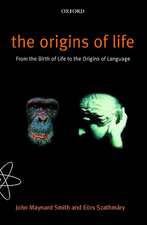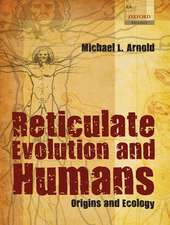Evolution through Genetic Exchange
Autor Michael L. Arnolden Limba Engleză Paperback – 10 oct 2007
Preț: 513.86 lei
Preț vechi: 604.54 lei
-15% Nou
Puncte Express: 771
Preț estimativ în valută:
98.34€ • 106.78$ • 82.60£
98.34€ • 106.78$ • 82.60£
Carte tipărită la comandă
Livrare economică 23 aprilie-07 mai
Preluare comenzi: 021 569.72.76
Specificații
ISBN-13: 9780199229031
ISBN-10: 0199229031
Pagini: 272
Ilustrații: 6 colour plates, numerous line drawings, 3 maps, 3 tables
Dimensiuni: 188 x 245 x 14 mm
Greutate: 0.55 kg
Editura: OUP OXFORD
Colecția OUP Oxford
Locul publicării:Oxford, United Kingdom
ISBN-10: 0199229031
Pagini: 272
Ilustrații: 6 colour plates, numerous line drawings, 3 maps, 3 tables
Dimensiuni: 188 x 245 x 14 mm
Greutate: 0.55 kg
Editura: OUP OXFORD
Colecția OUP Oxford
Locul publicării:Oxford, United Kingdom
Recenzii
...one of the strengths of this book is that the author's argument does not succeed or fail on the example of this single taxon, nor does he use exclusively botanical examples. Indeed, I recommend his interesting interpretation of the temporal fitness variation and relative abundance of between-species hybrids in Darwin's finches...[..] I very much liked the organization of this book and the author's placement of the discussion of the emthods early in the monograph. This helped set the stage for the latter presentation and interpretation of data...[..] this chapter and the examples in it provide a solid introduction to the logic of monograph. In an important way, this mehtodological discussion also usefully seperates the observational question, "Does in occur?" from the more contentious, interpretive question, "What does it mean"...[..] I recommend it highly.
Evolution Through Genetic Exchange represents a compelling argument for a paradigm shift in evolutionary biology, in which the Tree of Life is replaced conceptually by a Web of Life that connects all living organisms and their genomes. The Quarterly Review of Biology
Evolution Through Genetic Exchange represents a compelling argument for a paradigm shift in evolutionary biology, in which the Tree of Life is replaced conceptually by a Web of Life that connects all living organisms and their genomes. The Quarterly Review of Biology
Notă biografică
Michael Arnold is an evolutionary biologist with over 90 scientific articles to his credit. He is best known for the work produced by his group on the evolutionary role of natural hybridization - particularly relating to the plant group known as the Louisiana Irises. However, he has collaborated on evolutionary biology research projects involving organisms as diverse as bats, Columbines, fruit flies and fungi. He has published one other book, entitled Natural Hybridization and Evolution (Oxford University Press, 1997). Mike is also a published outdoor writer whose stories and photographs have appeared in such places as Safari Magazine. Mike and his wife Frances have two adult children, Brian and Jenny.














